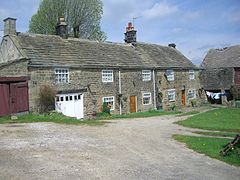Dungworth
| Dungworth | |
|---|---|
 Green Fold Farmhouse |
|
| Dungworth shown within Sheffield | |
| Civil parish |
|
| Metropolitan borough | |
| Metropolitan county | |
| Region | |
| Country | England |
| Sovereign state | United Kingdom |
| Post town | SHEFFIELD |
| Postcode district | S6 |
| Dialling code | 0114 |
| Police | South Yorkshire |
| Fire | South Yorkshire |
| Ambulance | Yorkshire |
| EU Parliament | Yorkshire and the Humber |
| UK Parliament | |
Dungworth (archaic Dungeworth,) is a hamlet in the civil parish of Bradfield, west of Sheffield in South Yorkshire, England.
The village also gives its name as a surname; a 'Dungworth' is recorded living at the nearby village of Storrs in 1323. In the late 20th century the English occurrences of the surname remained concentrated in the Sheffield area.
Dungworth is a hamlet located approximately 1.25 miles (2 km) west of Stannington and the outermost suburbs of Sheffield in agricultural high ground at around 200 m (660 ft) above sea level. It is 500 yards (0.5 km) south of the eastern end of Damflask reservoir. The village has a primary school Bradfield Dungworth School, and a public house, the Royal Hotel.
The village pub has long been a centre of village life, games of Knurr and Spell were played in the 1920s and there were clubs for fishing, running, football and cricket. At Christmas time people have sung local songs in the pub for over 200 years.
The village has a school "Bradfield Dungworth School" and a community hall.
A medieval cross, Dungworth Cross was once located northwest of the village. (grid reference SK 2780 9036)
Dungworth has a long tradition of dairy farming, and at one time there were eight dairy farms in the area, each delivering their own milk to the surrounding district, but this has been significantly reduced in recent years. A cruck barn at Briers House farm once used as a cowhouse and hayloft dates from the 16th century.
Manufacture of knives took place in Dungworth in the 17th and 18th centuries; the nearby 'Sykehouse' (c. 1800) at Syke House farm has hearths and workshop dating from the period. The census of 1861 shows a large number of men in the Dungworth, Hill Top and Storrs area who combined farming with the production of knives in small workshops attached to their cottages. Coal was mined near Dungworth up to the 19th century; it was found in association with ganister.
...
Wikipedia

